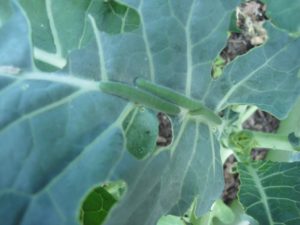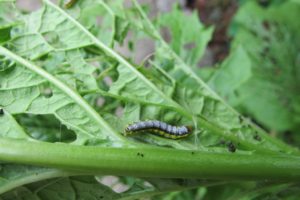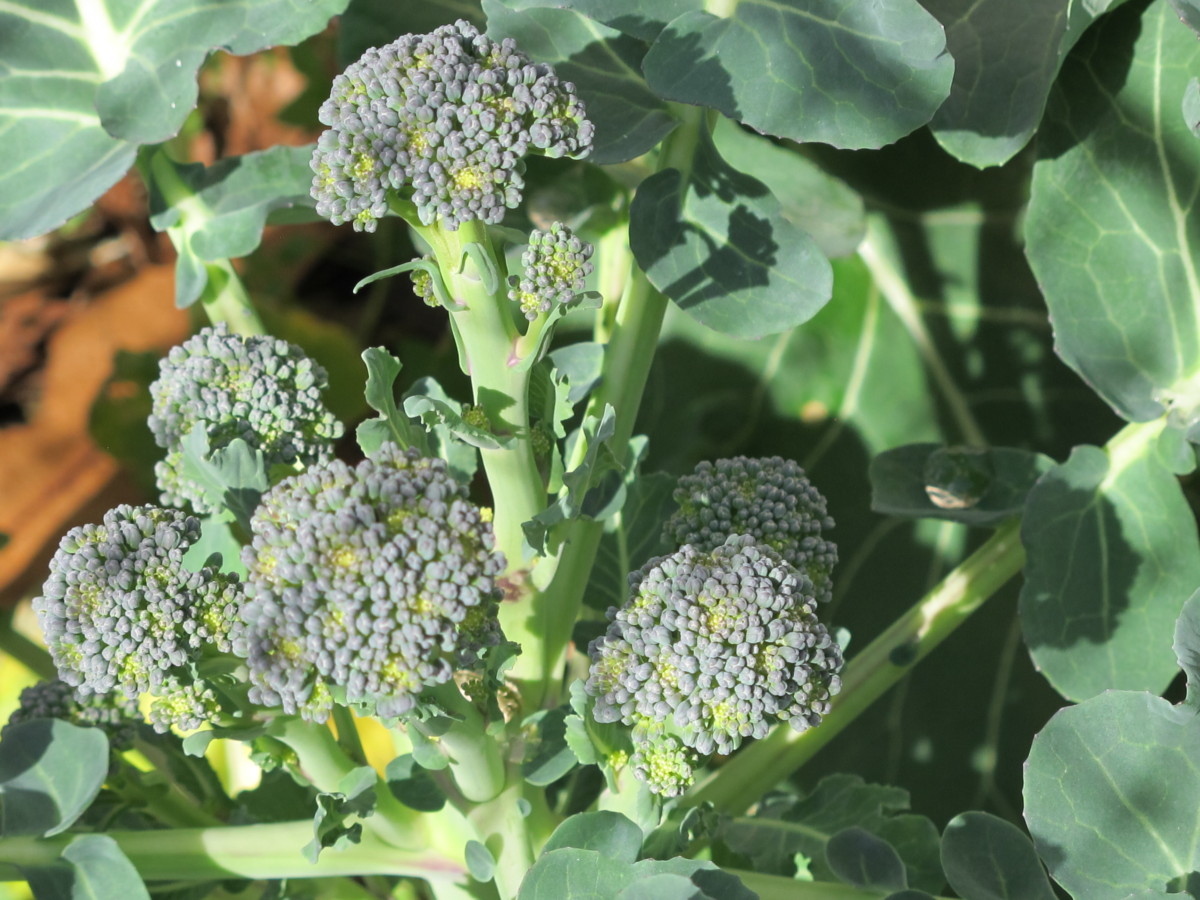Updated 4/30/2025
The route from “farm to table” can’t be any shorter than if it starts in your own back yard. Here are two broccoli recipes that take minutes to prepare, and might convince you to grow some plants this fall. 2 or 3 servings.
I added information on the beneficial antioxidants, called sulforaphanes, which are unique to this group of vegetables.
Easy Broccoli One:
The simple sauce:
- Finely mince a medium-large clove of garlic, and add to a small butter pot with 1-2 tsp. butter and 1-2 Tbsp. olive oil.
- Heat the garlic/oil over medium heat until garlic is a very light golden color. (Burned garlic tastes terrible. If you have to start over, that’s better than using it burned.) This step might take a bit longer than cooking the broccoli, so I start this one first. Remove pot from the heat when garlic is ready.
The broccoli:
- Use a medium size pot, with a lid. Add 2 or 3 Tbsp. water, and apply medium heat.
- Broccoli: Rinse a fresh crown, about 5″ in diameter. Remove the end of the tough, thick stem. Cut head into bite-size florets; remaining tender stems should be cut smaller. Some people don’t use the stems, just under the head, but they’re perfectly edible, as are the leaves. Place florets into the pot.
- Mushrooms: Trim stems, and rinse a few white button mushrooms. Slice, and add to the broccoli.
- Cover, heat up the contents, then lower the temperature to steam the broccoli and mushrooms. Stir a few times. Don’t overcook; cook until broccoli turns a bright dark green color, which takes only a minute or two. Overcooking this vegetable makes it soft and smelly.
- Drain water from the broccoli pot. Add the contents from the garlic pot to the broccoli, and a dash of salt. Mix and serve.
B and C vitamins are water soluble. Use as little water as possible so nutrients aren’t washed down the drain. Or, add the liquid to soup or freeze for later use.
This is a great, fast side dish by itself. Or use it over some enriched pasta, with a little more oil and grated Romano cheese. Photo, below—it’s dinner, with a few black olives on the side.
Easy Broccoli Two:
 In a medium frying pan, add about 3 Tbsp. thinly sliced onion and 1 or 2 Tbsp. olive oil. On medium heat, cook and turn until onion is transparent to a light golden color.
In a medium frying pan, add about 3 Tbsp. thinly sliced onion and 1 or 2 Tbsp. olive oil. On medium heat, cook and turn until onion is transparent to a light golden color.- Then add broccoli, cut into bite-size pieces, prepared as in Easy Broccoli One. Add 2 Tbsp. water and a dash of salt.
- Mix well, and cover to steam over low heat. Stir once or twice, adding water if necessary. It’s done when broccoli turns a bright green color or cook it to the desired tenderness, only a minute or two. Drain excess water.
- Serve with grated Romano cheese.
Wasn’t that easy? Delicious and super-healthy!
After trying these recipes, you might decide to grow your own broccoli. Start seeds, which germinate quickly, or look for transplants at your local garden center or farmers’ market in late summer/early autumn and again in late winter/early spring.
* * * * * *
Miniature Broccoli ‘Happy Rich’
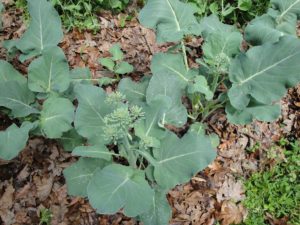
Miniature broccoli ‘Happy Rich’, my favorite vegetable.
You could also use a few stems of ‘Happy Rich’ miniature broccoli (photo, above) if they’re ready to pick. This variety has small heads with great flavor. Six to ten inches of the stem, the heads, and the leaves are edible.
After it has been cut, the remaining stems branch out and grow more stems… over and over… for months! Like several other brassicas, it tolerates freezing temperatures, and this one forms heads into early or midsummer. Lightly shaded during the hot afternoon hours in the summer, ‘Happy Rich’ might survive and produce a few cuts.
When temperatures cool down in late summer, mini broccoli grows more exuberantly, and survives an average winter here in USDA zone 7b. Mulch with oak leaves or other materials to moderate soil temperatures, hold moisture in the soil, and suppress weeds. The richer the soil (compost, aged cow manure, fish emulsion), the more tender the stems.
Because ‘Happy Rich’ is my favorite vegetable, I cover the plants on very cold winter nights to keep them producing. In 2022-2023, it produced harvests for more than 9 months! I grow 2-3 dozen plants for myself and to sell the occasional bunch at the farmers’ market.
If ‘Happy Rich’ doesn’t survive a hot summer, I’ll start seeds in late summer for fall, winter, and spring crops. (Note: I use a different variety of heading broccoli in autumn than I do in early spring. ‘Arcadia’ is one of the hardiest varieties I’ve grown, and it produces loads of side shoots through an average winter.)
You’re not alone in thinking that broccoli is “the gift that keeps on giving”.
Those Pesky Caterpillars!
- Imported cabbage worms on broccoli. Very tiny eggs are laid singly, usually on the bottom of a leaf.
- Adult form of imported cabbage worm.
- Cross-striped cabbageworm, becoming more common here, on mustard greens. Look for clusters of white woolly eggs.
Almost the entire group of brassicas attracts a few species of moths and one butterfly. Keep a small bottle of organic Bt (Bacillus thuringiensis) on hand to spray for the caterpillars from spring to just after frost.
Those caterpillars can ruin the crop in a very short period of time. Bt (brand names include Dipel and Thuricide) is a live organism, so store the bottle in a cool, dark place, and replace it every 3 years or so. It’s a naturally occurring bacterium that attacks only larvae of moths and butterflies, and nothing else. Perfectly safe to use, it easily rinses off the produce.
- Broccoli ‘Arcadia’ tolerates colder weather and produces several rounds of side shoots.
- Miniature broccoli ‘Happy Rich’ regrows after each cut.
Phytonutrients
Most of us know that broccoli and other members of the Brassicaceae family (arugula, Brussels sprouts, cabbage, cauliflower, collards, gai lan, kale, mustard greens, pac choi, tatsoi, and others) are “nutrient powerhouses”. They contain high levels of vitamin A (including retinol), several B vitamins (including folate), vitamins C and K, manganese, lutein, fiber, and phytonutrients. They also contain fair amounts of protein, omega-3 fatty acids, and other minerals.
Certain brassicas are higher in particular nutrients than others, so eat several representatives of this family to get all the nutrients they offer.
The brassicas, in fact, are the only crops that contain measurable amounts of a large group of extremely beneficial antioxidants called sulforaphanes. These antioxidants and others in brassicas can help prevent several forms of cancer, type 2 diabetes, cardiovascular disease, and other inflammatory illnesses. They also help preserve eyesight, skin health, and brain function.
Antioxidants hunt down and neutralize free radicals, which create molecular instability in our bodies. That instability can cause changes in DNA, leading to cancer.
Brassica antioxidants also boost our gut health. But for those suffering with intestinal disorders, consult your doctor first before making changes to your diet.
The way we cook these vegetables, however, largely determines whether or not we will be able to absorb those phytonutrients. Here’s why:
An enzyme within brassica tissues becomes activated when the foliage is bruised or cut. This enzyme, called myrosinase, facilitates the transformation of sulforaphane precursors into the sulforaphanes themselves. But myrosinase is destroyed by heat. Also, it takes 40+ minutes for the enzyme to make that transformation. So…cooking the broccoli or other brassicas right after cutting them up results in no sulforaphanes!
That’s why we should cut up the greens and let them sit on the cutting board or in the refrigerator for the time required to make the sulforaphanes.
Another way to get these antioxidants is to eat the brassicas raw. Try Brussels sprouts slaw, one of my favorites, for a healthy dose of raw Brussels sprouts. Cole slaw also is eaten raw, and provides a cool side dish on a hot summer day. Cabbage ‘Tiara’ grows a smaller head, and makes a great cole slaw.
If I don’t have the 40 minutes to wait, I’ll eat a few raw pieces of broccoli or kale to introduce myrosinase into my system. Then, the enzyme can work on the ingested cooked brassicas, so I’ll get more of the sulforaphanes.
Eating both raw and cooked brassicas (sometimes cooked immediately after chopping and sometimes cooked after the 40-minute delay) gives us a broader range of phytonutrients (including glucosinolates, isothiocyanates, and sulforaphanes.) Cooking at low temperatures preserves nutrient levels.
Because both sides of my family have a few serious chronic illnesses, I eat a good portion of brassicas at least once a day. Every day. So far, so good!
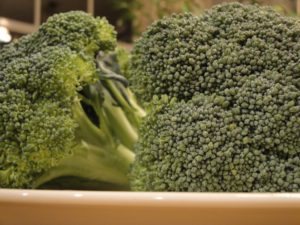
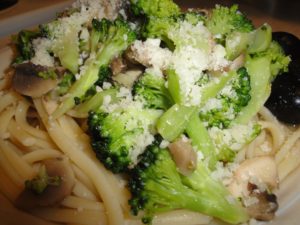
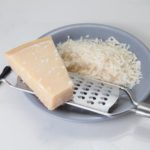 In a medium frying pan, add about 3 Tbsp. thinly sliced onion and 1 or 2 Tbsp. olive oil. On medium heat, cook and turn until onion is transparent to a light golden color.
In a medium frying pan, add about 3 Tbsp. thinly sliced onion and 1 or 2 Tbsp. olive oil. On medium heat, cook and turn until onion is transparent to a light golden color.